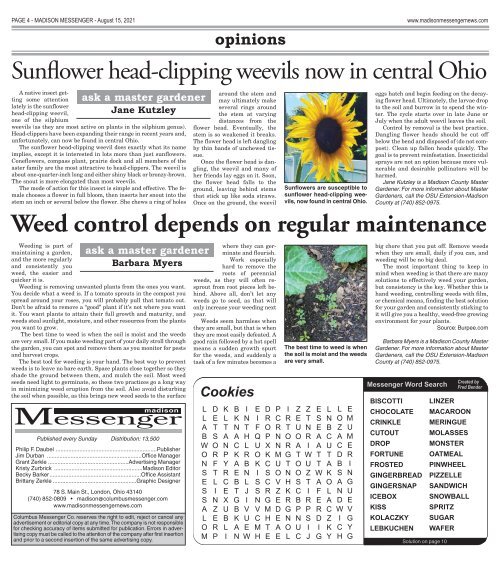Madison Messenger - August 15th, 2021
Create successful ePaper yourself
Turn your PDF publications into a flip-book with our unique Google optimized e-Paper software.
PAGE 4 - MADISON MESSENGER - <strong>August</strong> 15, <strong>2021</strong><br />
opinions<br />
www.madisonmessengernews.com<br />
Sunflower head-clipping weevils now in central Ohio<br />
A native insect getting<br />
some attention<br />
lately is the sunflower<br />
head-clipping weevil,<br />
one of the silphium<br />
ask a master gardener<br />
Jane Kutzley<br />
weevils (as they are most active on plants in the silphium genus).<br />
Head-clippers have been expanding their range in recent years and,<br />
unfortunately, can now be found in central Ohio.<br />
The sunflower head-clipping weevil does exactly what its name<br />
implies, except it is interested in lots more than just sunflowers.<br />
Coneflowers, compass plant, prairie dock and all members of the<br />
aster family are the most attractive to head-clippers. The weevil is<br />
about one-quarter-inch long and either shiny black or bronzy-brown.<br />
The snout is more elongated than most weevils.<br />
The mode of action for this insect is simple and effective. The female<br />
chooses a flower in full bloom, then inserts her snout into the<br />
stem an inch or several below the flower. She chews a ring of holes<br />
around the stem and<br />
may ultimately make<br />
several rings around<br />
the stem at varying<br />
distances from the<br />
flower head. Eventually, the<br />
stem is so weakened it breaks.<br />
The flower head is left dangling<br />
by thin bands of unchewed tissue.<br />
Once the flower head is dangling,<br />
the weevil and many of<br />
her friends lay eggs on it. Soon,<br />
the flower head falls to the<br />
ground, leaving behind stems<br />
that stick up like soda straws.<br />
Once on the ground, the weevil<br />
Sunflowers are susceptible to<br />
sunflower head-clipping weevils,<br />
now found in central Ohio.<br />
eggs hatch and begin feeding on the decaying<br />
flower head. Ultimately, the larvae drop<br />
to the soil and burrow in to spend the winter.<br />
The cycle starts over in late June or<br />
July when the adult weevil leaves the soil.<br />
Control by removal is the best practice.<br />
Dangling flower heads should be cut off<br />
below the bend and disposed of (do not compost).<br />
Clean up fallen heads quickly. The<br />
goal is to prevent reinfestation. Insecticidal<br />
sprays are not an option because more vulnerable<br />
and desirable pollinators will be<br />
harmed.<br />
Jane Kutzley is a <strong>Madison</strong> County Master<br />
Gardener. For more information about Master<br />
Gardeners, call the OSU Extension-<strong>Madison</strong><br />
County at (740) 852-0975.<br />
Weed control depends on regular maintenance<br />
Weeding is part of<br />
maintaining a garden,<br />
and the more regularly<br />
and consistently you<br />
weed, the easier and<br />
quicker it is.<br />
ask a master gardener<br />
Barbara Myers<br />
Weeding is removing unwanted plants from the ones you want.<br />
You decide what a weed is. If a tomato sprouts in the compost you<br />
spread around your roses, you will probably pull that tomato out.<br />
Don’t be afraid to remove a “good” plant if it’s not where you want<br />
it. You want plants to attain their full growth and maturity, and<br />
weeds steal sunlight, moisture, and other resources from the plants<br />
you want to grow.<br />
The best time to weed is when the soil is moist and the weeds<br />
are very small. If you make weeding part of your daily stroll through<br />
the garden, you can spot and remove them as you monitor for pests<br />
and harvest crops.<br />
The best tool for weeding is your hand. The best way to prevent<br />
weeds is to leave no bare earth. Space plants close together so they<br />
shade the ground between them, and mulch the soil. Most weed<br />
seeds need light to germinate, so these two practices go a long way<br />
in minimizing weed eruption from the soil. Also avoid disturbing<br />
the soil when possible, as this brings new weed seeds to the surface<br />
madison<br />
<strong>Messenger</strong><br />
Published every Sunday Distribution: 13,500<br />
Philip F. Daubel ................................................................Publisher<br />
Jim Durban ............................................................Office Manager<br />
Grant Zerkle ...................................................Advertising Manager<br />
Kristy Zurbrick ........................................................<strong>Madison</strong> Editor<br />
Becky Barker..........................................................Office Assistant<br />
Brittany Zerkle .....................................................Graphic Designer<br />
78 S. Main St., London, Ohio 43140<br />
(740) 852-0809 • madison@columbusmessenger.com<br />
www.madisonmessengernews.com<br />
Columbus <strong>Messenger</strong> Co. reserves the right to edit, reject or cancel any<br />
advertisement or editorial copy at any time. The company is not responsible<br />
for checking accuracy of items submitted for publication. Errors in advertising<br />
copy must be called to the attention of the company after first insertion<br />
and prior to a second insertion of the same advertising copy.<br />
where they can germinate<br />
and flourish.<br />
Work especially<br />
hard to remove the<br />
roots of perennial<br />
weeds, as they will often resprout<br />
from root pieces left behind.<br />
Above all, don’t let any<br />
weeds go to seed, as that will<br />
only increase your weeding next<br />
year.<br />
Weeds seem harmless when<br />
they are small, but that is when<br />
they are most easily defeated. A<br />
good rain followed by a hot spell<br />
means a sudden growth spurt<br />
for the weeds, and suddenly a<br />
task of a few minutes becomes a<br />
Cookies<br />
L<br />
L<br />
A<br />
B<br />
W<br />
O<br />
N<br />
S<br />
E<br />
S<br />
S<br />
A<br />
L<br />
O<br />
M<br />
D<br />
E<br />
T<br />
S<br />
O<br />
R<br />
F<br />
T<br />
L<br />
I<br />
N<br />
Z<br />
E<br />
R<br />
P<br />
K<br />
L<br />
T<br />
A<br />
N<br />
P<br />
Y<br />
R<br />
C<br />
E<br />
X<br />
U<br />
B<br />
L<br />
I<br />
B<br />
K<br />
N<br />
A<br />
C<br />
K<br />
A<br />
E<br />
B<br />
T<br />
G<br />
B<br />
K<br />
A<br />
N<br />
I<br />
N<br />
T<br />
H<br />
L<br />
R<br />
B<br />
N<br />
L<br />
J<br />
I<br />
V<br />
U<br />
E<br />
W<br />
E<br />
I<br />
F<br />
Q<br />
U<br />
O<br />
K<br />
I<br />
S<br />
S<br />
N<br />
V<br />
C<br />
M<br />
H<br />
D<br />
R<br />
O<br />
P<br />
X<br />
K<br />
C<br />
S<br />
C<br />
R<br />
G<br />
M<br />
H<br />
T<br />
E<br />
P<br />
C<br />
R<br />
N<br />
N<br />
M<br />
U<br />
O<br />
V<br />
Z<br />
E<br />
D<br />
E<br />
A<br />
E<br />
The best time to weed is when<br />
the soil is moist and the weeds<br />
are very small.<br />
I<br />
R<br />
T<br />
O<br />
R<br />
G<br />
T<br />
N<br />
H<br />
K<br />
R<br />
G<br />
N<br />
O<br />
L<br />
Z<br />
E<br />
U<br />
O<br />
A<br />
T<br />
O<br />
O<br />
S<br />
C<br />
B<br />
P<br />
N<br />
U<br />
C<br />
Z<br />
T<br />
N<br />
R<br />
I<br />
W<br />
U<br />
Z<br />
T<br />
I<br />
R<br />
P<br />
S<br />
I<br />
J<br />
E<br />
S<br />
E<br />
A<br />
A<br />
T<br />
T<br />
W<br />
A<br />
F<br />
E<br />
R<br />
D<br />
I<br />
G<br />
L<br />
N<br />
B<br />
C<br />
U<br />
T<br />
A<br />
K<br />
O<br />
L<br />
A<br />
C<br />
Z<br />
K<br />
Y<br />
L<br />
O<br />
Z<br />
A<br />
C<br />
D<br />
B<br />
S<br />
A<br />
N<br />
D<br />
W<br />
I<br />
C<br />
H<br />
E<br />
M<br />
U<br />
M<br />
E<br />
R<br />
I<br />
N<br />
G<br />
U<br />
E<br />
V<br />
G<br />
Y<br />
G<br />
big chore that you put off. Remove weeds<br />
when they are small, daily if you can, and<br />
weeding will be no big deal.<br />
The most important thing to keep in<br />
mind when weeding is that there are many<br />
solutions to effectively weed your garden,<br />
but consistency is the key. Whether this is<br />
hand weeding, controlling weeds with film,<br />
or chemical means, finding the best solution<br />
for your garden and consistently sticking to<br />
it will give you a healthy, weed-free growing<br />
environment for your plants.<br />
Source: Burpee.com<br />
Barbara Myers is a <strong>Madison</strong> County Master<br />
Gardener. For more information about Master<br />
Gardeners, call the OSU Extension-<strong>Madison</strong><br />
County at (740) 852-0975.<br />
<strong>Messenger</strong> Word Search<br />
BISCOTTI<br />
CHOCOLATE<br />
CRINKLE<br />
CUTOUT<br />
DROP<br />
FORTUNE<br />
FROSTED<br />
GINGERBREAD<br />
GINGERSNAP<br />
ICEBOX<br />
KISS<br />
KOLACZKY<br />
LEBKUCHEN<br />
Solution on page 10<br />
Created by<br />
Fred Bender<br />
LINZER<br />
MACAROON<br />
MERINGUE<br />
MOLASSES<br />
MONSTER<br />
OATMEAL<br />
PINWHEEL<br />
PIZZELLE<br />
SANDWICH<br />
SNOWBALL<br />
SPRITZ<br />
SUGAR<br />
WAFER


















